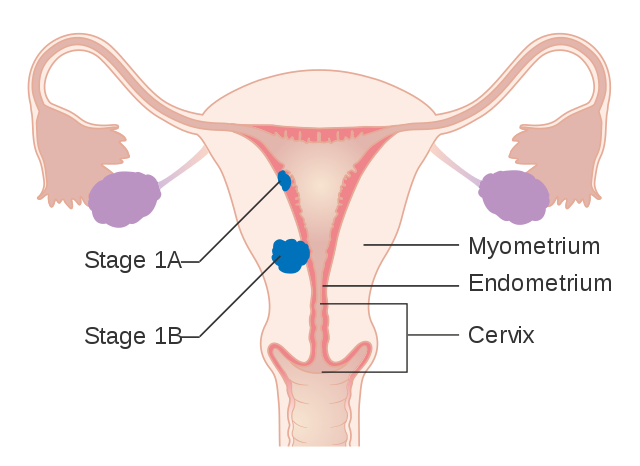Endometrial Cancer Stage 1 ICD 10 is C54.1.
Understanding your Stage 1 Endometrial Cancer diagnosis will help you partner with your doctors to make the best treatment choice for you. Tap “Listen Now” for an easy-to-understand audio overview of Stage 1 Endometrial Cancer.
- Stage 1A Endometrial Cancer
- Stage 1B Endometrial
Overview
Stage 1A Endometrial cancer diagnosis means that the cancer has been found only in the mucus membrane lining of your uterus, called the Endometrium, or the cancer is less that half way through the Myometrium as shown at the top of the image.
The Endometrium is the part of the uterus that thickens during your menstrual cycle to prepare for the potential arrival of an embryo. The Myometrium is muscle layer of the uterus.
What Tests Will I Need and Why?
Blood and Imaging tests are done to understand your general health, confirm your diagnosis and determine your cancer stage.
Tissue analysis is also typically done through a biopsy to identify the cancer cell type, which is critical to finding the best treatment option for you.
If your treatment team has not already performed tests to determine your cancer’s features, please ask your doctor when these tests will be performed.
Re-read this summary as needed and then tap, “Compare My Treatment Options Now“. Our unique Comparison Page will help you understand your FDA-approved treatment options including, who can help you pay for your treatment, where and how each is given and what side-effects you may experience.

Cancer Research U.K. CC BY-SA 4
Overview
Stage 1B Endometrial Cancer diagnosis means that the cancer has spread halfway or more into the Myometrium, the muscle layer of your uterus as indicated in this image by the larger blue tumor.
What Tests Will I Need and Why?
Blood and Imaging tests are done to understand your general health, confirm your diagnosis and determine your cancer stage.
Tissue analysis is also typically done through a biopsy to identify the cancer cell type, which is critical to finding the best treatment option for you.
If your treatment team has not already performed tests to determine your cancer’s features, please ask your doctor when these tests will be performed.
Re-read this summary as needed and then tap, “Compare My Treatment Options Now“. Our unique Comparison Page will help you understand your FDA-approved treatment options including, who can help you pay for your treatment, where and how each is given and what side-effects you may experience.

Cancer Research U.K. CC BY-SA 4
Recommended Endometrial Cancer Videos

Endometrial Cancer In The Black Community
Brought To You By Black Health Matters

Endometrial Cancer Overview
CDC Did You Know Series

How Cancer Spreads
Metastatic = Advanced

Diagnosing Your Cancer
How Does a PET Scan Work?

Diagnosing Your Cancer
How Does a CT Scan Work?

Exercise! You Can Do It
Reducing Side Effects & More
Commonly Searched Questions
Stage 1 Endometrial Cancer Treatment
Source: Texasoncology.com
Stage 1 Endometrial Cancer Survival Rate
Source: Cancer.gov
Stage 1 Endometrial Cancer Symptoms
- changes in the length or heaviness of menstrual periods
- vaginal bleeding or spotting between menstrual periods
- vaginal bleeding after menopause
- pelvic pain
Source: Cancer.org
Stage 1 Endometrial Cancer Recurrence Rate
Source: PubMed.gov
Stage 1 Endometrial Cancer Definition
- Stage 1A: The cancer is found only in the endometrium or has invaded the inner half of the myometrium (the muscular layer of the uterus).
- Stage 1B: The cancer has invaded the outer half of the myometrium but is still confined to the uterus.
Source: PubMed.gov
Stage 1 Endometrial Cancer Prevention
- Maintain a Healthy Weight: Obesity is a key risk factor, so keeping a healthy weight can reduce risk.
- Manage Diabetes: Effectively control diabetes, as it is linked to higher endometrial cancer risk.
- Use Birth Control Pills: Oral contraceptives may lower the risk of endometrial cancer.
- Discuss Hormone Therapy: If using hormone replacement therapy, consult your doctor to understand the risks and benefits.
Source: Cancer.org













